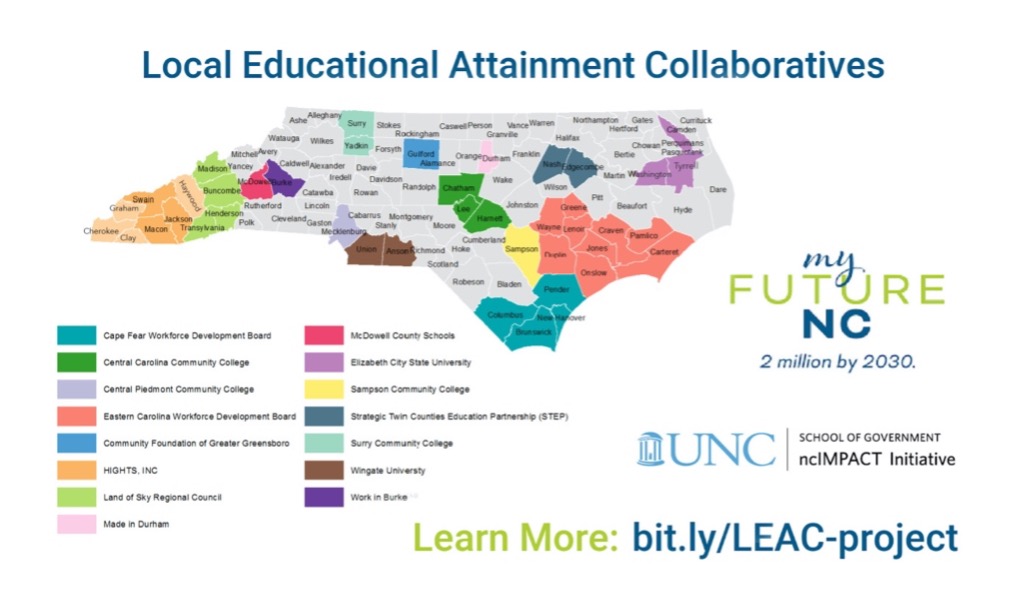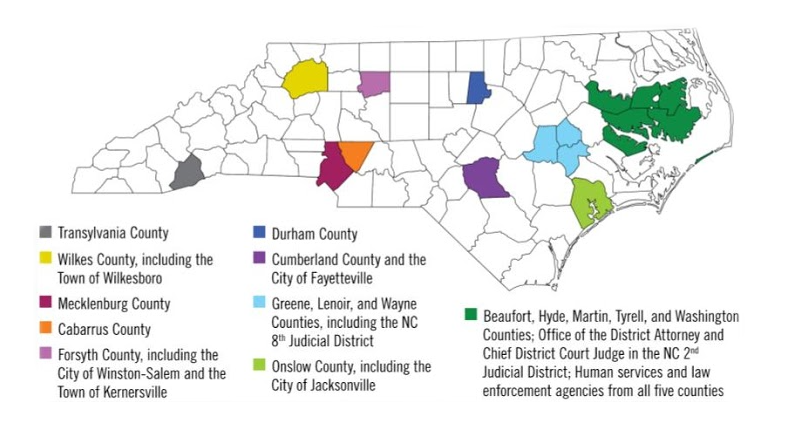The ncIMPACT Initiative Approach to Cross-Sector Collaborations
What are cross-sector collaboratives? The short answer is that these collaboratives tackle challenges that are too complex for any single individual, organization, or even sector to solve alone. Sometimes referred to as “wicked problems,” addressing these challenges requires a wide range of expertise from diverse stakeholders working in the non-profit, for-profit, and government sectors. ncIMPACT Initiative specializes in bringing these stakeholders together.

Co-authored by Caitlin Lancaster
In February 2022, the ncIMPACT Initiative showcased three of the 15 myFutureNC Local Educational Attainment Collaboratives (LEACs) working to amplify their impacts on the state’s goal of having 2 million residents with post-secondary degrees or high-quality credentials by 2030. The session took place during NC State’s annual Emerging Issues Forum. The LEACs received an extremely positive response from the audience, who appreciated the tremendous vision and sweat equity behind each collaborative, as well as the “real talk” about how hard collaboration can be. We think the presenters at the Emerging Issues Forum sparked a larger conversation about why communities are increasingly looking to launch cross-sector community collaboratives in efforts to combat significant challenges such as food insecurity, the opioid epidemic, and education disparities.
What are cross-sector collaboratives?
The short answer is that these collaboratives tackle challenges that are too complex for any single individual, organization, or even sector to solve alone. Sometimes referred to as “wicked problems,” addressing these challenges requires a wide range of expertise from diverse stakeholders working in the non-profit, for-profit, and government sectors. ncIMPACT Initiative specializes in bringing these stakeholders together.
Every cross-sector collaborative is different
There is sometimes a misconception that cross-sector collaboration processes yield cookie-cutter experiences and outcomes for communities. Nothing could be further from the truth. First, each community will come with its own vision for outcomes. For example, each of the three collaboratives highlighted at the Emerging Issues Forum offered different reasons for applying to participate and populations of focus. Made in Durham sought to close its educational attainment gap and, with a focus on young adults ages 14-25, offer opportunities for all residents to participate in the area’s rapid economic growth. Strategic Twin Counties Education Partnership applied to help employers in Nash and Edgecombe counties find skilled employees to fill vacant positions, as well as counter misperceptions among local K-12 students that the community has limited local career opportunities. GuilfordJobs2030 applied after merging their equity and economic development work to upskill more adults to help the region successfully compete economically. Similarly, each shared different challenges with engaging respective stakeholders. While one collaborative had great engagement from employers, another did not. The same was true for the engagement of the faith community. For all, the collaboratives find themselves building connections and trust among stakeholders who have and hold on to community history. That history makes the process different for each community.
The activities performed will also be different. For example, The Opioid Response Project, launched in 2018 and coordinated by the ncIMPACT Initiative, convened 10 cross-sector community collaboratives. Some focused on reducing stigma, and others focused on increasing awareness and knowledge of opioid addiction, use, and misuse, the impacts of opioid use on the community, and/or the prevention and treatment options available. Some sought to increase access to and engagement with treatment, and others to decrease access to opioids to prevent new substance use disorder cases in their communities.
When to use cross-sector collaboratives (or not)
Collaboration among sectors to try to solve complex and multi-layered challenges continues to grow as communities recognize the potential to create meaningful change. Most recently, we saw a number of collaborative vaccine distribution efforts offered by the private, public, and non-profit sectors. These different sectors in communities created collaboratives to develop a common strategy and implemented it using mutually reinforcing activities and consistent communication.
Different theoretical frameworks vary in the conditions for success that they highlight. However, all include components such as regular communication, building trust, having shared goals, and an understanding of “who is doing what.” For collaboratives to be successful, they must have a plan and means to help tackle the complex challenges at hand.
Because collaboratives are such hard work, communities need to think carefully about whether to engage in them, even when facing a complex challenge. Here is our checklist of early questions. If the answers to any of them are “no,” we advise against a cross-sector collaborative process.
- Are you really facing a problem no one sector can effectively address?
- Do you have some general agreement among stakeholders about the nature of the problem?
- Are there people who will serve as persistent champions for the process?
- Does trust exist among stakeholders, or will you be able to build it?
- Is there capacity to coordinate the work of the collaborative?
What you can expect
- These collaboratives bring together diverse groups from various sectors. Including perspectives from diverse sectors within a community or region can lead to workable solutions.
- Shared accountability among these organizations and groups can allow for shared risk. This shared risk can help to foster an environment of creativity as stakeholders are able to take collective risk without all the blame being placed on one organization or group if it is not successful.
- Allows for an exchange of knowledge, assets, and networks – or social capital. Social capital refers to connections, networks, or relationships among people and the value that arises from them. Each individual and organization has social capital with their own connections. When you bring multiple individuals and organizations together in a collaborative, they can reap the benefits of each other’s shared social capital. Connections made within the collaborative can last beyond their work together as well, which increases their collective long-term social capital.
- Cross-sector collaborative teams can increase individual, organizational, and local community capacity. The Evaluation Report from the Opioid Response Project (ORP) noted that participants from the collaboratives reported “significantly higher levels of individual capacity after participating in the ORP compared to before.” They also reported, “significantly higher team capacity to plan, implement, and evaluate their opioid initiative after participating in the ORP.”


